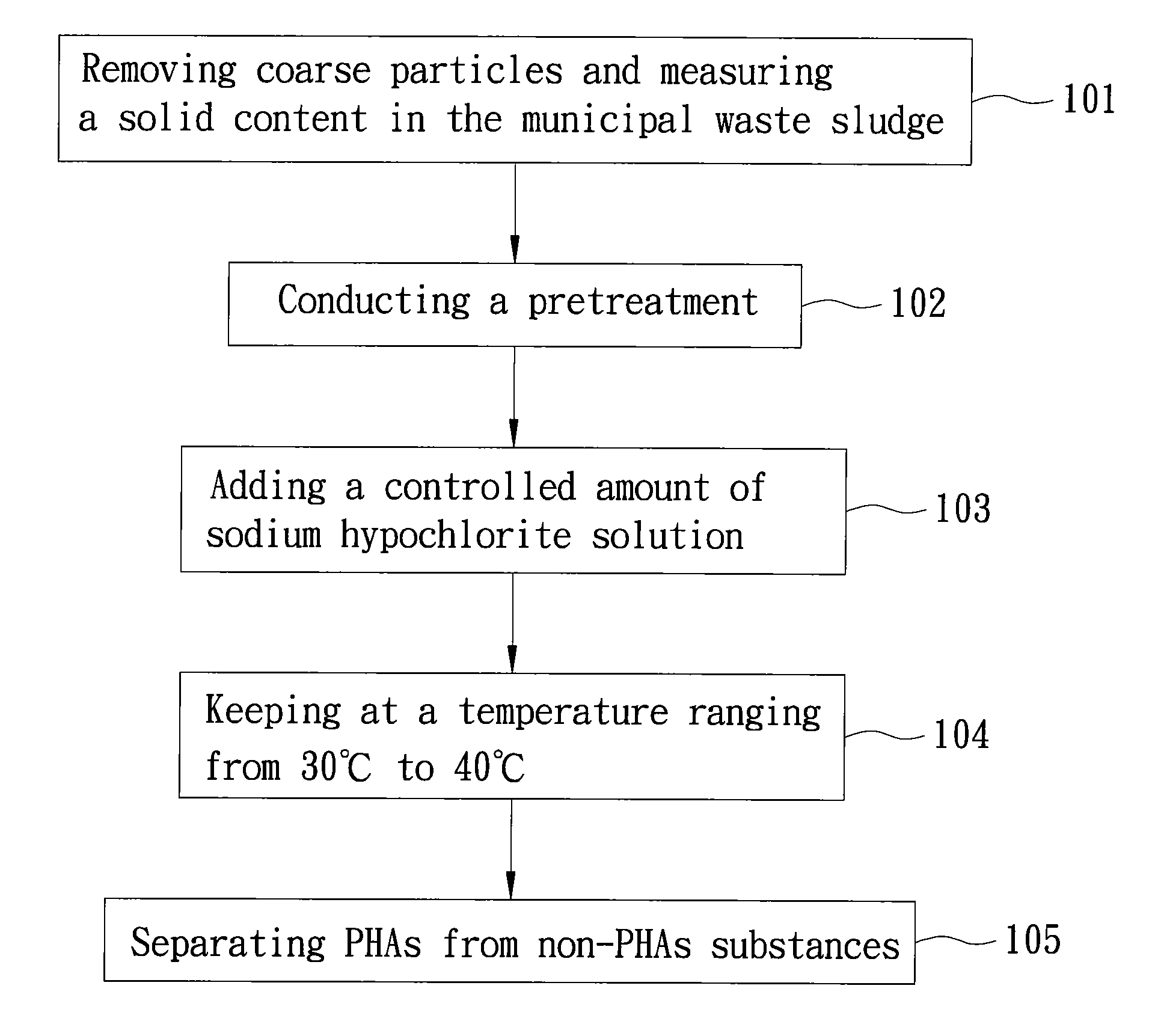Method of recovering polyhydroxyalkanoates (PHAS) from municipal waste sludge
a technology of municipal waste sludge and polyhydroxyalkanoate, which is applied in the direction of water/sewage treatment by oxidation, water/sludge/sewage treatment, chemistry apparatus and processes, etc., can solve the problem of high cost of recovering phas using conventional methods
- Summary
- Abstract
- Description
- Claims
- Application Information
AI Technical Summary
Benefits of technology
Problems solved by technology
Method used
Image
Examples
experiment 1
Effect of a Pretreatment on Recovery of PHAs (the First Preferred Embodiment)
[0055]A predetermined amount of municipal waste sludge was collected from a municipal wastewater treatment plant, and coarse particles in the municipal waste sludge were removed using a 1 mm filter screen, followed by conducting MLSS analysis on 20 mg-30 mg of the sludge that has been screened to measure the solid content in the screened sludge. The screened sludge was centrifuged at 3000 rpm to remove a supernatant therefrom, and frozen at −20° C. to obtain a frozen sludge. Although the step of freezing the screened sludge may be omitted, in order to prevent PHAs in the polyhydroxyalkanoates (PHAs) producing microbial species from being metabolized, it is preferable to conduct a freezing step for 1 hour. In the first experiment, four test samples of the frozen sludge were prepared, and were respectively subjected to the following four different pretreatments: (i) adding 5 ml of a sodium hypochlorite soluti...
experiment 2
Effect of a Concentration of Sodium Hypochlorite Solution in Step 103 on Recovery of PHAs (the First Preferred Embodiment)
[0059]Twelve test samples were prepared following the procedure used in experiment 1 except that the twelve test samples were all subjected to the pretreatment (iv), and that the concentration of the sodium hypochlorite solutions added in the step 103 are 2 v / v %, 5 v / v %, 10 v / v %, 15 v / v %, 20 v / v %, 25 v / v %, 30 v / v %, 35 v / v %, 40 v / v %, 60 v / v %, 80 v / v %, and 100 v / v %, respectively. The liquid-solid ratio is 1 mg / ml for all test samples. Furthermore, the treated sludge for each test sample was centrifuged at 3000 rpm for 20 minutes to remove a supernatant therefrom, was reacted with 10 ml of acetone for 20 minutes, followed by centrifugation at 3000 rpm for 20 minutes to remove a supernatant (i.e., non-polyhydroxyalkanoate materials) from the treated sludge and to obtain a purified PHAs precipitate.
[0060]After measuring the weight of the PHAs precipitate a...
experiment 3
Effect of a Liquid-Solid Ratio on Recovery of PHAs (the First Preferred Embodiment)
[0061]Seven test samples were prepared following the procedure employed in experiment 2 except that the concentration of the sodium hypochlorite solution added in the step 103 is set to 20 v / v %, and that the liquid-solid ratios for the seven test samples are 0.33 mg / ml, 0.40 mg / ml, 0.50 mg / ml, 0.67 mg / ml, 0.75 mg / ml, 0.85 mg / ml and 0.95 mg / ml, respectively.
[0062]The test results of the experiment 3 are shown in FIG. 4. The PHAs purities of the seven test samples are 11.7±0.05 wt %, 19.0±0.60 wt %, 28.2±0.72 wt %, 53.6±2.73 wt %, 50.7±2.83 wt %, 49.7±4.27, wt %, and 39.4±3.07 wt %, respectively. The PHAs contents of the seven test samples are 13.2±0.06 mgPHA / gVSS, 15.8±0.14 mgPHA / gVSS, 19.6±0.02 mgPHA / gVSS, 26.2±0.28 mgPHAs / gVSS, 19.9±0.48 mgPHA / gVSS, 18.4±1.09 mgPHA / gVSS, and 16.7±0.22 mgPHA / gVSS, respectively. When the liquid-solid ratio increases from 0.33 mg / ml to 0.67 mg / ml, both of PHAs purity a...
PUM
 Login to View More
Login to View More Abstract
Description
Claims
Application Information
 Login to View More
Login to View More - R&D
- Intellectual Property
- Life Sciences
- Materials
- Tech Scout
- Unparalleled Data Quality
- Higher Quality Content
- 60% Fewer Hallucinations
Browse by: Latest US Patents, China's latest patents, Technical Efficacy Thesaurus, Application Domain, Technology Topic, Popular Technical Reports.
© 2025 PatSnap. All rights reserved.Legal|Privacy policy|Modern Slavery Act Transparency Statement|Sitemap|About US| Contact US: help@patsnap.com



